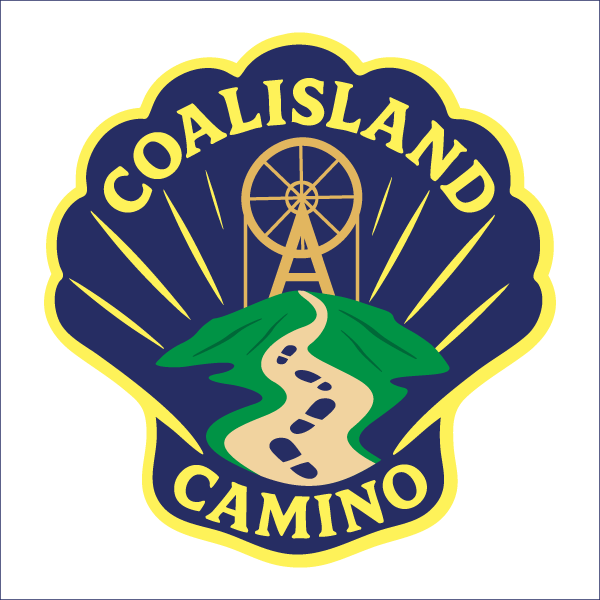PILGRIMAGE
Port Naomh (Portneive), is a site rich in spiritual and historical significance, nestled along the River Blackwater. It lies parallel to the Derryloughan Road, leading toward Maghery Ferry.
Today, it forms part of the Coalisland Camino pilgrimage trail, specifically between the Curlew and Maghery Ferry stamp points. The name Port Naomh translates as “the landing place of the saints,” a title steeped in religious lore and spiritual heritage. Historically, it was where devout travellers moored their boats before embarking on pilgrimages deeper into the heart of Ulster, to Tyrone, Derry, and Donegal.
Local tradition tells us that this very spot marks the landing of St. Patrick when he arrived in East Tyrone. He was said to be journeying towards the ancient parishes of Ballyclog and Donaghenry, now known collectively as Coalisland Parish. The parish church of St. Mary & Joseph (stamp point) stands as a spiritual beacon, reflecting generations of worshippers and centuries of Christian faith rooted in this landscape.
Records of Ballyclog and Donaghenry stretch back to around 900 A.D., but oral traditions trace religious activity in the region to St. Patrick’s time, some 450 years earlier. Early ecclesiastical writings reference the saint’s missionary efforts here, affirming the enduring influence he had on shaping the spiritual identity of East Tyrone.
The ancient parish of Clonoe’s oldest Christian Church (St. Michaels – believed to have been built in the 15th Century, pre-reformation) originally bore the name St. Comgall (510-602 AD), and it was believed monks associated with St. Comgall likely established a branch in Clonoe at this time. St. Brigid, another of Ireland’s most venerated saints, is also linked with Port Naomh. According to legend, she stopped here on her journey from Kildare to Ardboe, adding further weight to the port’s spiritual importance.
Tradition alludes that St. Colum Cille arrived at Port Naomh on his journey across Lough Neagh from Derry to Armagh, with the local Roman catholic Church at Kingsisland bearing his name. The earliest documented reference to Clonoe parish was in the 1302 ‘Papal Decree’ when the Parish was required to pay 10 shillings per year to Rome. The surrounding area, particularly Maghery, played a central role in trade and travel between Armagh and southern Tyrone.
In fact, an ancient route known as St. Patrick’s Trail is believed to have passed through Port Naomh, connecting Armagh to Coney Island by a network of causeways. Archaeological traces of this path have been found in the nearby townlands, including Derryloughan, reinforcing Port Naomh’s role as a key node in both sacred and secular journeys. Port Naomh served as a landing place not only for local pilgrims but also for those travelling from distant regions such as north Tyrone, Donegal, south Antrim, and Derry.
It was a gateway for those crossing Lough Neagh and the River Blackwater into County Armagh. Some of these pilgrims journeyed to renowned Christian destinations in Spain, France, and throughout Europe, while others arrived in Ireland from abroad to visit sacred sites across Northern Ulster. Thus, Port Naomh was not merely a local stop; it was a crossroads of continental pilgrimage, resonating with the movement of faith across borders.
In more recent history, the old Dublin to Coleraine coach route passed through Roskeen, crossing what was locally called the Holy River (stamp point), before the construction of the modern Ferry Road. This old path echoed the ancient pilgrim routes and is now integrated into the Coalisland Camino.
Local accounts even speak of ghostly echoes of the past, describing the sound of horses’ hooves and iron wheels echoing through the night, as if the phantom coach still journeyed through time.
Another poignant waypoint on the Camino is St. Patrick’s Church (stamp point) in Clonoe, near the B161 road connecting Coalisland to Ardboe. In July 1602, this very road saw the march of Lord Mountjoy’s English soldiers.
They had earlier that day destroyed the inauguration seat of the O’Neill chieftains at Tullaghogue Fort and then attacked a fortified crannóg on Roughan Lough, close to a stamp location on the Camino trail.
These actions marked a turning point in Irish history. Crieve Lough Crannóg, near Stewartstown, is deeply tied to one of Ireland’s most transformative events. Hugh O’Neill, the last great Gaelic lord of Ulster, spent his final night in Tyrone on this man-made island before beginning the fateful Flight of the Earls in 1607. His departure symbolised the end of the Gaelic order and the dawn of English colonial dominance.
Though the Earls intended to sail to Coruna, Spain, they landed in France due to bad weather. Their journey, however, continues to be retraced by local people today, turning it into a modern-day pilgrimage. The legacy of this history remains strongest in Spain.
The O’Donnell family was granted hereditary titles and became the Dukes of Tetúan, while the O’Neill family received the title of Marqués del Norte and established a military tradition. These connections underscore the far-reaching impact of the people and places tied to Port Naomh, a humble landing place that became a spiritual and historical anchor for generations.
